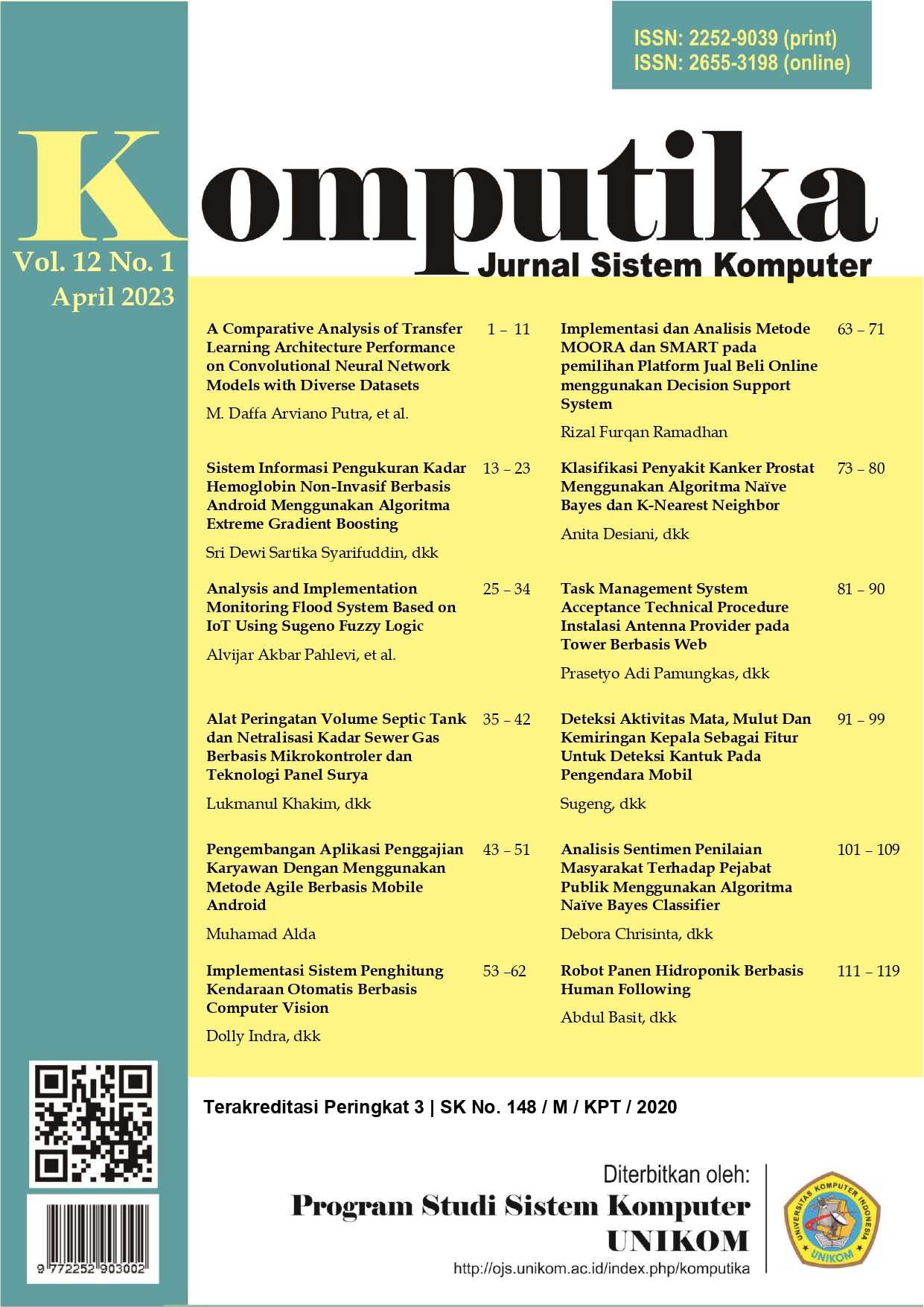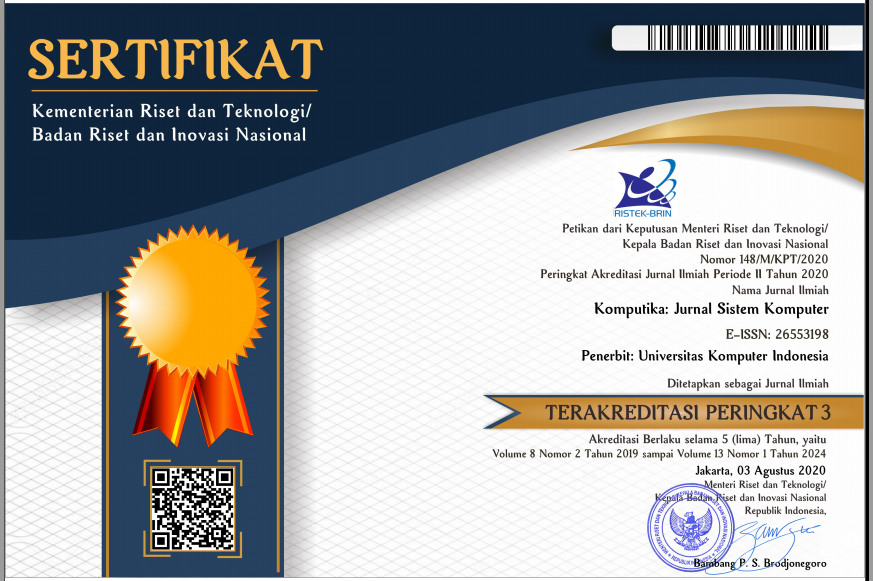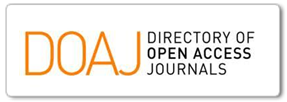Deteksi Aktivitas Mata, Mulut Dan Kemiringan Kepala Sebagai Fitur Untuk Deteksi Kantuk Pada Pengendara Mobil
DOI:
https://doi.org/10.34010/komputika.v12i1.9688Abstract
Drowsiness in four-wheeled drivers is one of the factors that cause traffic accidents. Drowsiness can be caused due to the tiredness of the journey that is passed by the driver. Utilization of artificial intelligence can be used to detect a driver's drowsiness, one of which is by observing eye activity or condition, mouth movement, and head position while driving. By knowing all these conditions, a machine can be made that can give a warning if the driver experiences possible drowsiness. This study utilizes a camera as data input to recognize the condition of the driver through activity, eyes, mouth, and head tilt position. The system will start by detecting the rider's face, then calculating each activity of eye blinking, the number or number of mouths open due to yawning, as well as head activity through poses and tilt of the head position. Face detection is used to determine the position of the face and then detect the position of the driver's eyes, mouth, and head. Utilizing artificial intelligence with the Blazeface method which is an algorithm used to map facial positions. As well as using the EAR (Eye Aspect Ratio) method to be able to determine whether the eyes and mouth are open or closed. The results of this study obtained a face detection accuracy of 98% and the system can only detect faces at an angle of 0-15 degrees.
Keywords – Face Recognition, Mediapipe, Face Extraction, Machine Learning, Blazeface.
References
A. P. Setiany, D. Noviyanto, M. Irfansyahfalah, S. Aisah, Y. Yulianti, and I. Kusyadi, ‘Implementasi Kecerdasan Buatan untuk Memantau Lahan Pertanian’, J. Teknol. Sist. Inf. Dan Apl., vol. 4, no. 3, Art. no. 3, Jul. 2021, doi: 10.32493/jtsi.v4i3.12022.
Y. Wangsajaya, M. Zarlis, and Z. Situmorang, ‘Model Pengukuran Layanan POLRI Berbasis Kecerdasan Buatan’, Pros. Semin. Nas. Ris. Inf. Sci. SENARIS, vol. 4, no. 2, Art. no. 2, Jul. 2022, doi: 10.30645/senaris.v4i2.209.
S. Sugeng and A. Mulyana, ‘Sistem Absensi Menggunakan Pengenalan Wajah (Face Recognition) Berbasis Web LAN’, J. Sisfokom Sist. Inf. Dan Komput., vol. 11, no. 1, pp. 127–135, Apr. 2022, doi: 10.32736/sisfokom.v11i1.1371.
S. I. Lestariningati, A. B. Suksmono, I. J. M. Edward, and K. Usman, ‘Group Class Residual ℓ1-Minimization on Random Projection Sparse Representation Classifier for Face Recognition’, Electronics, vol. 11, no. 17, Art. no. 17, Jan. 2022, doi: 10.3390/electronics11172723.
B. Susanto, F. Purnomo, and M. Fahmi, ‘Sistem Keamanan Pintu Berbasis Pengenalan Wajah Menggunakan Metode Fisherface’, J. Ilm. Inov., vol. 17, Aug. 2017, doi: 10.25047/jii.v17i1.464.
F. Fahrizal, ‘IMPLEMENTASI SISTEM PENGENALAN WAJAH UNTUK KEAMANAN AKSES BERBASIS UBUNTU MENGGUNAKAN PYTHON’, JIKA J. Inform., vol. 5, p. 210, Jun. 2021, doi: 10.31000/jika.v5i2.4509.
R. G. Alam and R. Toyib, ‘IMPLEMENTASI ALGORITMA EIGENFACE UNTUK FACE RECOGNITION PADA OBJECK FOTO ID CARD’, vol. 7, no. 2, p. 9, 2015.
S. Al-Aidid and D. Pamungkas, ‘Sistem Pengenalan Wajah dengan Algoritma Haar Cascade dan Local Binary Pattern Histogram’, J. Rekayasa Elektr., vol. 14, no. 1, pp. 62–67, Apr. 2018, doi: 10.17529/jre.v14i1.9799.
V. Bazarevsky, Y. Kartynnik, A. Vakunov, K. Raveendran, and M. Grundmann, ‘BlazeFace: Sub-millisecond Neural Face Detection on Mobile GPUs’. arXiv, Jul. 14, 2019. Accessed: Jul. 11, 2022. [Online]. Available: http://arxiv.org/abs/1907.05047
‘Face Detection for Real World Application | IEEE Conference Publication | IEEE Xplore’. https://ieeexplore.ieee.org/abstract/document/9445287 (accessed Mar. 25, 2023).
I. Supriana and Y. Suryadharma, ‘Deteksi Posisi dan Ekstraksi Fitur Wajah Manusia Pada Citra Berwarna’, Nov. 2009.
N. W. Pratiwi, F. Fauziah, S. Andryana, and A. Gunaryati, ‘Deteksi Wajah Menggunakan Hidden Markov Model (HMM) Berbasis Matlab’, STRING Satuan Tulisan Ris. Dan Inov. Teknol., vol. 3, no. 1, Art. no. 1, Aug. 2018, doi: 10.30998/string.v3i1.2538.
Y. Wu and Q. Ji, ‘Facial Landmark Detection: A Literature Survey’, Int. J. Comput. Vis., vol. 127, no. 2, pp. 115–142, Feb. 2019, doi: 10.1007/s11263-018-1097-z.
A. D.n, C. Nugraha, and H. Prassetiyo, ‘Perancangan Alat Deteksi Dini Kondisi Kantuk untuk Mengurangi Risiko Kecelakaan Kerja Berbasis Pengolahan Citra Digital’, FTI, 2022, Accessed: Mar. 25, 2023. [Online]. Available: https://eproceeding.itenas.ac.id/index.php/fti/article/view/1718
Dewi Amalia and Fitri Utaminingrum, ‘Deteksi Kantuk pada Pengemudi melalui Jumlah Kedipan Mata Menggunakan Facial Landmark berbasis Intel NUC | Jurnal Pengembangan Teknologi Informasi dan Ilmu Komputer’. https://j-ptiik.ub.ac.id/index.php/j-ptiik/article/view/10283 (accessed May 23, 2023).
A. Z. Rahman, K. Jauhari, D. Sumantri, T. Hendro, I. D. Nugraha, and S. Amrullah, ‘Inverse Kinematics dan Pengukuran Akurasi Pergerakan pada Model Robot Manipulator Lengan’, J. Tek. MESIN, vol. 3, no. 2, 2019.
A. Ardiansiah, W. Setiawan, and L. Linawati, ‘Sistem Pengenalan Wajah Dengan Metode Face Features’, J. SPEKTRUM, vol. 3, no. 2, pp. 21–25, 2016.
‘MediaPipe’. https://mediapipe.dev/ (accessed May 19, 2022).



















